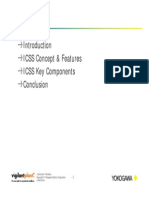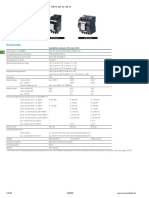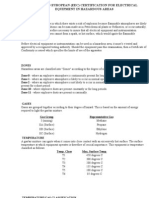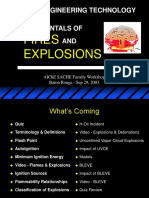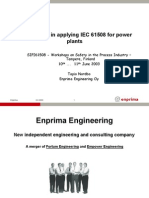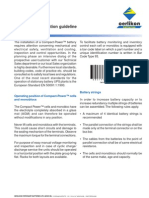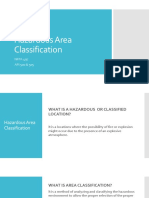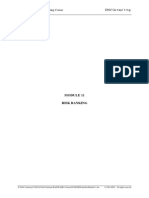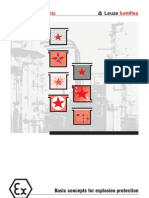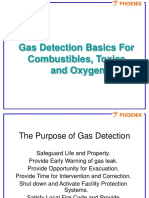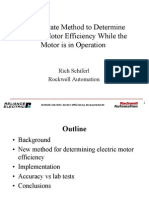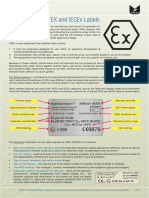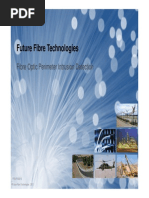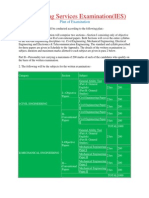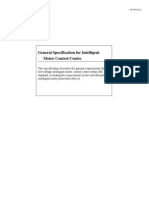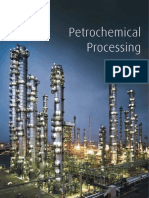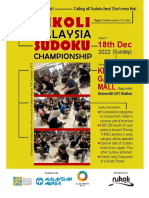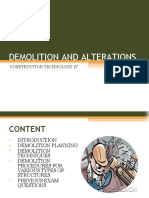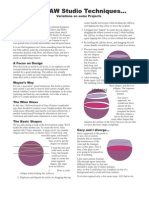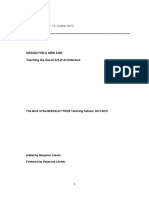Redapt Hazardous Area Guide
Redapt Hazardous Area Guide
Uploaded by
scribd8421Copyright:
Available Formats
Redapt Hazardous Area Guide
Redapt Hazardous Area Guide
Uploaded by
scribd8421Copyright
Available Formats
Share this document
Did you find this document useful?
Is this content inappropriate?
Copyright:
Available Formats
Redapt Hazardous Area Guide
Redapt Hazardous Area Guide
Uploaded by
scribd8421Copyright:
Available Formats
Page 1
HAZARDOUS AREA TECHNICAL GUIDE
The Redapt Hazardous Area Technical Guide provides an overview for the design and use of equipment used within potentially explosive atmospheres created by gases, vapours and ignitable dusts or bres.
Typically this includes such installations as oil/gas rigs, processing reneries, chemical production facilities, ammable liquids storage facilities, fuel transportation, petrol stations, paint production, paper production etc, however this list is not exhaustive and many new areas may be re-classied as hazardous. A hazardous area is dened as an area in which the atmosphere contains, or may contain in sufcient quantities, ammable or explosive gases, dusts or vapours. In such an atmosphere a re or explosion is possible when three basic conditions are met. This is often referred to as the hazardous area or combustion triangle.
FUEL
OXYGEN
In order to protect installations from a potential explosion a method of analysing and classifying a potentially hazardous area is required. The purpose of this is to ensure the correct selection and IGNITION installation of equipment to ultimately prevent SOURCE an explosion and to ensure safety of life. The methods used to classify an installation can vary depending upon which part of the world it is located, but generally there are two main types of classication. In countries that have adopted the IEC (International Electrotechnical Commission) philosophy this is referred to as Zoning whilst in North American installations are classied by Classes, Divisions and Groups to ascertain the level of safety required.
Redapt Engineering Company Limited Units 46 & 47 Darlaston Central Trading Estate Salisbury Street, Darlaston West Midlands. WS10 8XB United Kingdom Telephone No.: 44 (0) 121 526 7058 Fax No.: 44 (0) 121 526 5076 Email: redapt@redapt.co.uk
Page 2
SECTION 1
Classication -IEC and ATEX Standards
A Hazardous Area is dened by three main criteria, these being: The type of hazard (groups) The auto-ignition temperature of the hazardous material (temperature or T rating) The likelihood of the hazard being present in ammable concentrations (zones)
The Type of Hazard
The type of hazard will be in the form of either a gas or vapour or a dust or bre. The classication of these hazardous is primarily divided into two groups depending on whether it is in a mining or above surface industry. These are dened below: Group I -electrical equipment for use in mines and underground installations susceptible to redamp Group II and Group III -electrical equipment for use in surface installations Groups II & III are further sub-divided depending upon the hazard. Group II gases are grouped together based upon the amount of energy required to ignite the most explosive mixture of the gas with air. Group III dusts are subdivided according to the nature of the explosive atmosphere for which it is intended.
Mining Group I Group II
Surface Industry Group III
Electrical equipment for places with an explosive dust atmosphere Sub-Division Explosive Atmosphere IIIA IIIB IIIC Combustible yings Non-conductive dust Conductive dust
Electrical equipment for mines Electrical equipment for places with susceptible to redamp an explosive gas atmosphere Sub-Division IIA IIB IIC Ignition Energy 260 Microjoules 95 Microjoules 18 Microjoules
Page 3
Auto Ignition Temperature or T Rating
The hazard level of the gases increases from gas group IIA to IIC with group IIC being the most severe. Substances in this group can be ignited very easily with Hydrogen being the most at risk to ignition. The temperature class is based on the auto-ignition temperature of the gas, details of which are given below.
Apparatus Groups and Temperature Classes for Common Flammable Gases and Vapours Group II
Gas Group I IIA Temperature Class T1 Methane Acetone Methane Ethane Benzene Methanol Toluene Propane Acetic Acid Ammonia IIB Coal Gas Ethylene Ethylene oxide Propanol 1 Methyl Ethyl Ketone IIC Hydrogen Acetylene Ethylene glycol Hydrogen Sulphide Tetrahydrofuran Ethyl Methyl Ether Ethanol Cyclohexane Propanol 2 N-Butyl alcohol N-butane Diesel fuel Aircraft fuel Fuel oil N-Hexane Heptane Kerosene Acetaldehyde T2 T3 T4 T5 T6
Temperature Class Rating for Group II Electrical Apparatus
Group II Temperature Class T Code T1 T2 T3 T4 T5 T6 Maximum Surface Temperature 450C 300C 200C 130C 100C 85C Ignition temperature > 450C > 300C 450C > 200C 300C > 130C 200C > 100C 135C > 85C 100C
Page 4
If a hazardous is present the equipment used within the installation must be given an appropriate T classication in order to maintain the integrity. If that hazardous is, say, hydrogen, then all equipment used must meet the T6 rating. This means that all equipment used must not have a surface temperature of greater than 85C. Any equipment used that can generate a hotter surface temperature of greater than 85C must not be used as this will then increase the likelihood of an explosion by igniting the hydrogen in the atmosphere.
Apparatus Groups and Temperature Classes for Common Flammable Dusts and Fibres Group III
When considering installations that are at risk of a potential explosion due to dust ignition, the equipment used is classied in much the same way as with gases. No equipment should be installed where the surface temperature of the equipment is greater than the ignition temperature of the given hazard. Below are some common dust hazardous and their minimum ignition temperature. Ignition Temperatures for Common Flammable Dusts and Fibers Material Coal Dust Polythene Methyl Cellulose Starch Flour Sugar Grain Dust Phenolic Resin Aluminium PVC Soot Ignition Temperature Cloud 380C 420C 420C 460C 490C 490C 510C 530C 590C 700C 810C Layer 225C (melts) 320C 435C 340C 460C 300C > 450C > 450C > 450C 570C
The Likelihood of the Hazard
The likelihood of the hazard being present in a concentration high enough to cause an ignition will vary from location to location. For most installations this risk is dependant upon how long the hazard (gas, vapour, dust or bre) is present. In order to classify this danger an installation is divided into areas of risk depending upon the amount of time the hazardous is present. These areas are referred to as Zones.
Page 5
For gases and vapours and dusts and bres there are three zones:
Gas Zone 0 Zone 1 Zone 2 Dust Zone 20 Zone 21 Zone 22 Hazardous Area Characteristics A hazardous atmosphere is highly likely to be present and may be present for long periods of time (>1000 hours per year) or even continuously A hazardous atmosphere is possible but unlikely to be present for long periods of time (>10 <1000 hours per year A hazardous atmosphere is not likely to be present in normal operation or infrequently and for short periods of time (<10 hours per year)
Protection Concepts
There are varying types of equipment that can be used within these zones to ensure that the potential for an explosion is removed or greatly reduced. This equipment must be designed and manufactured in accordance with particular construction parameters known as protection concepts. Essentially these concepts fall under four main methods. These methods are detailed below along with a brief description of some of the concepts: Type of Protection Method Intended to prevent a potential ignition arising Intended to limit the ignition energy of the equipment Equipment Code Ex e Ex nA Ex ia Ex ib Ex ic Ex nL Ex p Ex px Ex py Intended to prevent the explosive atmosphere contacting the ignition source Ex pz Ex m Ex ma Ex mb Ex o Ex nR Intended to prevent an ignition from escaping outside the equipment Special Ex d Ex q Ex nC Ex s Description Increased safety Type -n protection Intrinsic safety ia Intrinsic safety ib Intrinsic Safety ic Type -n protection Purge/pressurized protection Purge/pressurized protection px Purge/pressurized protection py Purge/pressurized protection pz Encapsulation Encapsulation Encapsulation Oil immersion Type -n protection Flameproof protection Sand / powder (quartz) lling Type -n protection Special protection International Standard IEC 60079-7 IEC 60079-15 IEC 60079-11 IEC 60079-11 IEC 60079-11 IEC 60079-15 IEC 60079-2 IEC 60079-2 IEC 60079-2 IEC 60079-2 IEC 60079-18 IEC 60079-18 IEC 60079-18 IEC 60079-18 IEC 60079-15 IEC 60079-1 IEC 60079-5 IEC 60079-15 See IEC 60079-0 Suitable for Zones 1, 2 2 0, 1, 2 1,2 2 2 1, 2 1, 2 1, 2 2 1, 2 0, 1, 2 1, 2 1, 2 2 1, 2 1, 2 2 0, 1, 2
Page 6
Ex i Intrinsic Safety A protection concept in which the electrical energy within the equipment is restricted to a level which is below that what may cause an ignition or to limit the heating of the surface of the equipment. There are two main sub types to Ex i protection, these being ia and ib. Type ia protection allows for the occurrence of two faults during operation Type ib protection allows for the occurrence of one fault during operation. Ex d Flameproof The equipment that may cause an explosion is contained within an enclosure which can withstand the force of an explosion and prevent transmission to the outside hazardous atmosphere. This method of protection also prevents the hazardous atmosphere from entering the enclosure and coming into contact with equipment. Ex m Encapsulation A protection concept where by equipment that could potentially cause an ignition is encapsulated within a compound or resin so as to prevent contact with the explosive atmosphere. The concept also limits the surface temperature of the equipment under normal operating conditions. Ex e Increased Safety Precautions are applied to the installation to ensure increased security against the possibility of excessive temperatures and sparks from electrical equipment. Equipment that normally causes sparks is excluded from use within this method of protection. Ex p Pressurised One process ensures that the pressure inside an enclosure is sufcient to prevent the entrance of a ammable gas, vapour, dust, or bre and prevent a possible ignition. Another process maintains a constant ow of air (or an inert gas) to dilute to take away any potentially explosive atmosphere. Ex o Oil Immersion All equipment that has the potential to arc and potentially cause an ignition is immersed in a protective liquid or oil. The oil provides an insulating method to prevent ignition. Ex q Powder Filling All equipment that has the potential to arc is contained within an enclosure lled with quartz or glass powder particles. The powder lling prevents the possibility of an ignition.
Page 7
Ex n Non-Sparking A type of protection where precautions are taken so that electrical equipment that has the potential to arc is not capable of igniting a surrounding explosive atmosphere. This can be further categorised as follows: Ex nA -Where components used in construction are nonsparking Ex nC -Where components used in construction are nonincendive Ex nR Where components used are tightly enclosed to restrict the breathing and prevent ignition Ex nL -Where components used in construction do not contain enough energy to cause an ignition Ex s Special This method of protection, as its name indicates, has no specic parameters or construction rules. In essence it is any method of protection which can provide a pre-determined level of safety to ensure that there is no potential for an ignition. As such it does not fall under any specic protection method and may in fact be a combination of more than one. Ingress Protection Another consideration in the protection of equipment in hazardous areas is the safeguarding against the ingress of solid foreign objects and water. This is known as the degree of ingress protection and is commonly referred to as the IP Code. The relevant standard for the degree of ingress protection is IEC 60529. An overview of the IP code as dened in the standard is detailed below:
1st Numeral 0 1 2 3 4 5 Degree of Protection No protection at all against solid objects Protection against solid objects greater than 50 mm in diameter Protection against solid objects greater than 12.5 mm in diameter Protection against solid objects greater than 2.5 mm in diameter Protection against solid objects greater than 1.0 mm in diameter Protected against the ingress of dust in such an amount that it will not interfere with the operation of the equipment Total protection against the ingress of any dust 2nd Numeral 0 1 2 3 4 5 Degree of Protection No protection at all against the ingress of water Protected against falling water drops Protected against falling water drops at an angle of up to 15 Protected against sprayed water at an angle of up to 60 Protected against the splashing of water from any direction Protected against water jets from any direction Protected against powerful water jets from any direction Protected against the ingress of water when temporary immersed between 0.15 m and 1 m Protected against the ingress of water when continuously immersed to a specied depth
6 7
Page 8
Operational Temperatures All equipment used within hazardous areas has an operational temperature band or limit. This is often referred to as the Tamb and denes the upper and lower ambient temperatures of which the equipment is approved for use in. As dened in IEC 60079-0 the standard limits are 20C to +40C. Where the operation temperatures of the equipment fall between these parameters no additional marking is required. However, if they are outside these parameters than the specic temperatures need to be identied. Marking of Hazardous Area Equipment All equipment for use in hazardous areas should be marked as prescribed in 60079-0. As a general rule this includes, where appropriate, such information as: - Company/Manufacturers name and address - Hazardous area certicate number(s) - Protection concept -Gas group(s) - Temperature class - Ambient temperature range - Product identication - Serial number and year of manufacture - Electrical parameters - CE marking and ATEX notied Body ID number - ATEX coding -IP code
Page 9
SECTION 2
Classication North American Standards
In North American installations, hazardous areas are dened by classes, divisions, and groups to classify the level of safety required for equipment installed in these locations. Classes dene the type of hazard in terms of whether it is a gas or vapour, a combustible or conductive dust or an ignitable bre or ying. Divisions dene the probability of the presence of the hazard being present during normal or abnormal conditions. Groups classify the exact type and nature of the hazardous substance. An overview of this classication system can be dened as follows: Classes Class I Denition A location in which a ammable gas or vapour is or may be present in sufcient quantity to cause an explosive atmosphere A location in which a conductive or combustible dust is or may be present in sufcient quantity to cause a re or an explosive hazard. A location in which easily ignitable bres or yings are present in sufcient quantity to present a serious risk of re
II
III Classes Class 1 2 Groups Class A B
Denition The dened hazard is present during normal operational conditions The dened hazard is present only during abnormal conditions such as equipment failure.
Representative Hazard Acetylene Hydrogen Ethylene
D E F G
Propane Metal Dust Coal Dust Grain Dust
Page 10
Marking of Hazardous Location Equipment The marking of hazardous location equipment varies in accordance with the relevant Electrical Code. As a general rule equipment should be marked as follows: - Company/Manufacturers name - Class I, II and/or III - Division 1 and/or 2 - Group A, B, C, D, E, F and/or G - Approving NRTL (Nationally Recognized Testing Laboratory) logo - Product identication - Serial number - Other relevant safety information - Enclosure Type Rating Basic UL / CSA / NEMA Enclosure Types
Type 3 An enclosure which is intended for outdoor use primarily to provide a degree of protection against windblown dust, rain, sleet and damage from external ice formation Type 3R An enclosure which is intended for outdoor use primarily to provide a degree of protection against falling rain and damage from external ice formation Type 3S An enclosure which is intended for outdoor use primarily to provide a degree of protection against rain, sleet, windblown dust, and to provide for operation of external mechanisms when ice laden Type 4 An enclosure which is intended for indoor or outdoor use primarily to provide a degree of protection against windblown rain and dust, splashing water, hose directed water and damage from external ice formation Type 4X An enclosure which is intended for indoor or outdoor use primarily to provide a degree of protection against corrosion, windblown rain and dust, splashing water, hose directed water and damage from external ice formation Type 6 An enclosure which is intended for indoor or outdoor use primarily to provide a degree of protection against falling dirt, hose directed water, the entry of water during occasional temporary submersion at a specied depth and damage from external ice formation.
Page 11
Type 6P An enclosure which is intended for indoor or outdoor use to primarily to provide a degree of protection against falling dirt, hose directed water and the entry of water during prolonged submersion at a specied depth and damage from external ice formation.
This information has been compiled for guidance purposes only for equipment intended for use in potentially explosive atmospheres. This guide was assembled based on available technical knowledge at time of compilation. However regulations and legislations are subject to updates and the information provided within this guide may have been superseded. All equipment must be designed, selected and installed in accordance with appropriate regulations and governing legislation appropriate to its use. Redapt Engineering Company Limited 2007
Redapt Engineering Company Limited Units 46 & 47 Darlaston Central Trading Estate Salisbury Street, Darlaston West Midlands. WS10 8XB United Kingdom Telephone No.: 44 (0) 121 526 7058 Fax No.: 44 (0) 121 526 5076 Email: redapt@redapt.co.uk
You might also like
- Vilros Raspberry Pi User Guide by VilrosDocument151 pagesVilros Raspberry Pi User Guide by Vilrosqborrada10100% (2)
- 0530b4f5ec562edc711a PDFDocument100 pages0530b4f5ec562edc711a PDFrahmatmemet80% (10)
- Yokogawa ICSS Overview PDFDocument73 pagesYokogawa ICSS Overview PDFscribd8421100% (3)
- Yokogawa ICSS Overview PDFDocument73 pagesYokogawa ICSS Overview PDFscribd8421100% (3)
- Technical Data: GHG 618 Installation Contactor 20 A Up To 32 ADocument4 pagesTechnical Data: GHG 618 Installation Contactor 20 A Up To 32 Akhairalla mohamedNo ratings yet
- Information Transmission Modulation and NoiseDocument21 pagesInformation Transmission Modulation and NoiseJagritiKumari0% (2)
- Hazardous Areas Are Defined by Three Main CriteriaDocument5 pagesHazardous Areas Are Defined by Three Main Criteriaswarm62No ratings yet
- A Guide To European (Eec) Certification For Hzardus AreasDocument5 pagesA Guide To European (Eec) Certification For Hzardus AreasDeepak DinkarNo ratings yet
- Hazardous Area Classification QuestionsDocument9 pagesHazardous Area Classification QuestionsVraja KisoriNo ratings yet
- Explosion Protection Theory and Practice - Phoenix ContactDocument40 pagesExplosion Protection Theory and Practice - Phoenix Contactcuongphan123No ratings yet
- Hazardous Areas Are Defined by Three Main CriteriaDocument10 pagesHazardous Areas Are Defined by Three Main CriteriaviddyadrianNo ratings yet
- Hazardous Area Classification Innoil & Gas IndustryDocument34 pagesHazardous Area Classification Innoil & Gas Industrygastro9956No ratings yet
- Hazardous AreasDocument118 pagesHazardous AreaskamalNo ratings yet
- Jumo-Explosion ProtectionDocument80 pagesJumo-Explosion ProtectionEliana ChavesNo ratings yet
- Cooper - Intrinsic Safety GuideDocument20 pagesCooper - Intrinsic Safety Guidetkdrt2166100% (2)
- 4461271Document79 pages4461271Thoufik AhmedNo ratings yet
- Atex 7700e-185977Document9 pagesAtex 7700e-185977Bright OkunkpolorNo ratings yet
- Electrical Fires CausesDocument16 pagesElectrical Fires Causesingdimitriospino_110No ratings yet
- Electrical SymbolDocument14 pagesElectrical SymbolOrlando E Cabrera RojasNo ratings yet
- BV Requirement For UPS Back Up TimeDocument3 pagesBV Requirement For UPS Back Up TimeVishnu LalNo ratings yet
- Experience in Applying IEC61508 For Power PlantDocument24 pagesExperience in Applying IEC61508 For Power Plantmamo_nakuNo ratings yet
- Sis & SilDocument65 pagesSis & SilGecNo ratings yet
- Why Choose Intrinsic SafetyDocument4 pagesWhy Choose Intrinsic Safetysandystays100% (1)
- Intrinsic Safety: Basic PrinciplesDocument13 pagesIntrinsic Safety: Basic PrinciplesJessica SimonNo ratings yet
- Ventilatie RO-RO ENGDocument28 pagesVentilatie RO-RO ENGSimon LaurentNo ratings yet
- TSS SS400 YokogawaDocument12 pagesTSS SS400 YokogawahenryhariyadiNo ratings yet
- Installation Ventilation Guideline OerlikonDocument9 pagesInstallation Ventilation Guideline OerlikonandytuorNo ratings yet
- Electrical Equipment in Hazardous Areas - UploadDocument99 pagesElectrical Equipment in Hazardous Areas - UploadRajeev ValunjkarNo ratings yet
- Starting Methods of Syncronous Motor Criollo - RoggerDocument7 pagesStarting Methods of Syncronous Motor Criollo - RoggerRogger FabricioNo ratings yet
- Risk Note On Explosion Risks in Battery Rooms PDFDocument6 pagesRisk Note On Explosion Risks in Battery Rooms PDFKapil DevNo ratings yet
- Hazard Area ClassificationDocument13 pagesHazard Area ClassificationCobra_007No ratings yet
- S01 IEC61508 and Functional Safety System Selection v1 4Document34 pagesS01 IEC61508 and Functional Safety System Selection v1 4megavolt1No ratings yet
- P&F ATEX Types of ProtectionDocument48 pagesP&F ATEX Types of ProtectionMilkNo ratings yet
- Chemical Safety & Security - Fire ProtectionDocument33 pagesChemical Safety & Security - Fire Protectionsimbua72No ratings yet
- 25 Hazmat Recognition and IdentificationDocument18 pages25 Hazmat Recognition and IdentificationNagi Nouman100% (1)
- Module11 - Risk RankingDocument8 pagesModule11 - Risk RankingMinh ThưNo ratings yet
- Ex Protection TypesDocument37 pagesEx Protection Typesbrkygnr100% (1)
- Gas Detection Basics For Combustibles, Toxics and OxygenDocument48 pagesGas Detection Basics For Combustibles, Toxics and OxygenNguyen DatNo ratings yet
- What Is HIPOT Testing (Dielectric Strength Test) - EEPDocument7 pagesWhat Is HIPOT Testing (Dielectric Strength Test) - EEPmahmoud fawzyNo ratings yet
- Compressor - 101Document66 pagesCompressor - 101Juan Pablo Chavez Ixtepan100% (1)
- Explosionproof and Flameproof Enclosures - Part-2Document9 pagesExplosionproof and Flameproof Enclosures - Part-2HujiLokoNo ratings yet
- IEC 60079-33 - Equipment Protection by Special Protection 'S' - Edition 1.0 - 2012Document42 pagesIEC 60079-33 - Equipment Protection by Special Protection 'S' - Edition 1.0 - 2012Institute of Marketing & Training ALGERIANo ratings yet
- Motor EfficiencyDocument28 pagesMotor EfficiencyMani KandanNo ratings yet
- Safeti 3D Explosions - The Delta - MexicoDocument20 pagesSafeti 3D Explosions - The Delta - MexicolopezmoramiguelNo ratings yet
- Background To SCADA: 1.1 Introduction and Brief History of SCADADocument9 pagesBackground To SCADA: 1.1 Introduction and Brief History of SCADAAhmedNo ratings yet
- Ver2-0 Part 01 Ignition PropertiesDocument24 pagesVer2-0 Part 01 Ignition PropertieschewbaccyNo ratings yet
- SS 512-2005 - PreviewDocument11 pagesSS 512-2005 - PreviewJohn50% (2)
- NHP - Hazardous Area GuideDocument8 pagesNHP - Hazardous Area GuideMidhunNo ratings yet
- FDS User Guide PDFDocument393 pagesFDS User Guide PDFOscar MolinaNo ratings yet
- ATEX HandoutDocument7 pagesATEX Handoutanon_666816666No ratings yet
- ATEX-Guide - 1087 en Version 2Document61 pagesATEX-Guide - 1087 en Version 2mac1677No ratings yet
- BatteryRoom Air Change HourDocument1 pageBatteryRoom Air Change HourAakash SharmaNo ratings yet
- Sil Explained - Valve World 2009 PDFDocument5 pagesSil Explained - Valve World 2009 PDFshaonaaNo ratings yet
- Comparison of TNO Multienergy and Baker-Strehlow-Tang ModelsDocument4 pagesComparison of TNO Multienergy and Baker-Strehlow-Tang ModelsAgung Ariefat LubisNo ratings yet
- Iec61508 Uses and AbusesDocument5 pagesIec61508 Uses and Abusesuserscribd2011No ratings yet
- Seminar (PLC)Document29 pagesSeminar (PLC)upendra35No ratings yet
- Emergency Relief System Design Using DIERS Technology: The Design Institute for Emergency Relief Systems (DIERS) Project ManualFrom EverandEmergency Relief System Design Using DIERS Technology: The Design Institute for Emergency Relief Systems (DIERS) Project ManualRating: 4 out of 5 stars4/5 (1)
- Distributed Control System A Complete Guide - 2020 EditionFrom EverandDistributed Control System A Complete Guide - 2020 EditionNo ratings yet
- Redapt Hazardous Area GuideDocument11 pagesRedapt Hazardous Area GuidekarthipetroNo ratings yet
- Hazardous AREA ClassificationDocument10 pagesHazardous AREA Classificationfarzam100% (1)
- Hazardous Areas: Gases and VapoursDocument10 pagesHazardous Areas: Gases and VapoursShah JayNo ratings yet
- Electrical Equipment in Hazardous AreasDocument5 pagesElectrical Equipment in Hazardous AreasCARLOS MIGLIARONo ratings yet
- Hazardous Area ZonesDocument8 pagesHazardous Area ZonessiddharthangandhiNo ratings yet
- Ilinox Atex LineDocument13 pagesIlinox Atex LineDidit AndiatmokoNo ratings yet
- Hazardous Area & Temp ClassificationDocument12 pagesHazardous Area & Temp Classificationsatyajit_naibNo ratings yet
- How VPLS WorksDocument2 pagesHow VPLS Worksscribd8421100% (1)
- Engineering Solenoid ValveDocument26 pagesEngineering Solenoid ValveArnezNo ratings yet
- Fire Detection and Alarm System BasicsDocument115 pagesFire Detection and Alarm System Basicsscribd8421100% (9)
- FFT Perimeter Intrusion DetectionDocument58 pagesFFT Perimeter Intrusion Detectionscribd8421No ratings yet
- Process Control SystemsDocument242 pagesProcess Control SystemsAbdul_KSANo ratings yet
- IES SyllabusDocument20 pagesIES Syllabusscribd8421No ratings yet
- Water Treatment Handbook by ADILDocument134 pagesWater Treatment Handbook by ADILscribd8421100% (10)
- Cea - Standard Technical Specification For Main Plant Package (2 500 MW)Document1,011 pagesCea - Standard Technical Specification For Main Plant Package (2 500 MW)vasudevapavanNo ratings yet
- Motorsys Advanced Blokset Spec enDocument10 pagesMotorsys Advanced Blokset Spec enscribd8421No ratings yet
- Petrochemical ProcessingDocument8 pagesPetrochemical Processingscribd8421100% (1)
- Chapter-11 Types of Energy Meters & Accuracy ClassDocument3 pagesChapter-11 Types of Energy Meters & Accuracy ClassIrfan UllahNo ratings yet
- PVDF PipeDocument4 pagesPVDF PipeIbhar Santos MumentheyNo ratings yet
- Force Push or PullDocument9 pagesForce Push or PullWak GalokNo ratings yet
- Add/Modify/Resize/Change/Delete/Drop/Re Name MS SQL Server Table Column Using T-SQLDocument3 pagesAdd/Modify/Resize/Change/Delete/Drop/Re Name MS SQL Server Table Column Using T-SQLSandeep NayakNo ratings yet
- Historical Inquiry RubricDocument2 pagesHistorical Inquiry RubricCarmel MNo ratings yet
- 11th Malaysia Sudoku Championship Brochure - FinalDocument2 pages11th Malaysia Sudoku Championship Brochure - FinalVaishnavi KrishnanNo ratings yet
- Av Gad Av 2008 Dublo, Av 2016 DubloDocument60 pagesAv Gad Av 2008 Dublo, Av 2016 DubloPeraDetlicNo ratings yet
- Datasheet Skum Sprinkler IHH W Foam Sprinkler PDFDocument1 pageDatasheet Skum Sprinkler IHH W Foam Sprinkler PDFcld72No ratings yet
- README ScryptDocument5 pagesREADME ScryptPeanuts AmNo ratings yet
- Crusher Dust As Partial Cement Replacement Materrial in ConcreteDocument138 pagesCrusher Dust As Partial Cement Replacement Materrial in ConcreteZELALEMNo ratings yet
- Nist GCR 08-917-1Document31 pagesNist GCR 08-917-1jhunereasNo ratings yet
- Do You Believe in Magic Computer Games in EverydayDocument21 pagesDo You Believe in Magic Computer Games in EverydayVianni IsitchoNo ratings yet
- Fuselage and Tail Sizing (Lectures 23 To 30) : KeywordsDocument15 pagesFuselage and Tail Sizing (Lectures 23 To 30) : KeywordsShankar ManoNo ratings yet
- Dimarzio Product CatalogDocument16 pagesDimarzio Product CatalogSeen TeohNo ratings yet
- Demolition and Alterations: Construction Technology IvDocument75 pagesDemolition and Alterations: Construction Technology IvLaici Kang0% (1)
- Emergency Procedures For Operation of Gas Turbine.Document2 pagesEmergency Procedures For Operation of Gas Turbine.MARISSA DINLASAN100% (2)
- Smart Shoes For Visually Impaired PeopleDocument4 pagesSmart Shoes For Visually Impaired PeopleMohamed HanyNo ratings yet
- Coreldraw Studio Techniques : (Delete)Document2 pagesCoreldraw Studio Techniques : (Delete)Atanas IvanovNo ratings yet
- Polyglass TanksDocument2 pagesPolyglass Tanksale.dislacNo ratings yet
- Feb MM09Document2 pagesFeb MM09SaintJosephNo ratings yet
- Design For A New AgeDocument368 pagesDesign For A New AgeFidel MartinezNo ratings yet
- Replacement Light BulbsDocument5 pagesReplacement Light Bulbsmrock_1No ratings yet
- Anaeroide 767 PDFDocument2 pagesAnaeroide 767 PDFCesar MolanoNo ratings yet
- Led LCD Monitor: Owner'S ManualDocument28 pagesLed LCD Monitor: Owner'S ManualRaviSharmaNo ratings yet
- Turbomach Titan 130Document1 pageTurbomach Titan 130gilen30No ratings yet
- ME101 Tutorial 02Document4 pagesME101 Tutorial 02alex albNo ratings yet
- Dresding Medical CaseDocument8 pagesDresding Medical Casemichellebaileylindsa100% (1)


